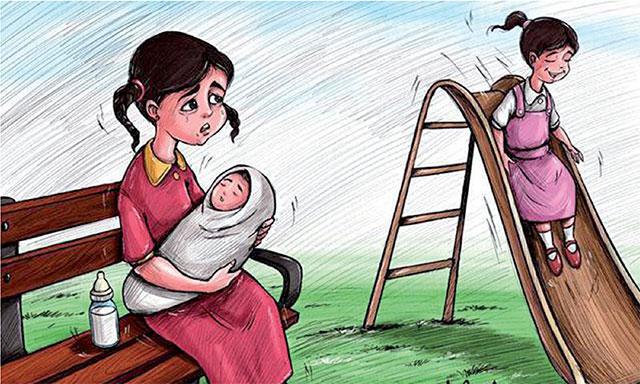What are social norms?
Social norms are the perceived informal, mostly unwritten, rules that define acceptable and appropriate actions within a given group or community, thus guiding human behaviour.1,2,3 They consist of what we do, what we believe others do, and what we believe others approve of and expect us to do. Social norms are therefore situated at the interplay between behaviour, beliefs and expectations.4 Social norms are learned and accepted from an early age, often in infancy,5 and held in place by social sanctions (‘punishments’) for non-adherence to the norm and social benefits (‘rewards’) for adherence.
If people conform to the norm, they expect to be socially accepted or rewarded; if they do not conform, they expect to be socially punished or excluded.6 A social norm exists when individuals practise a behaviour because they believe that others like them or in their community practise the behaviour (descriptive norms), or because they believe that those who matter to them approve of them practising the behaviour (injunctive norm).
WHEN IS IT NOT A SOCIAL NORM?
Not all behaviours are driven by social norms. In some cases, people choose to engage in a behaviour for reasons that do not depend on what others think or do. For example, people may engage in unhealthy or harmful behaviours because of a lack of knowledge, a low-risk perception about the negative consequences of the behaviour, an inability to perform alternative behaviours, emotions associated with the behaviour and so on. These factors are not social norms because they are independent of what others think or do.Before designing an intervention, it is important to assess the behaviour in question and its determinants to establish whether norms are at play or not.
Why do social norms matter?
Social norms can have beneficial or harmful consequences for people’s well-being. They are central to how social order is produced and maintained in society.7 Social norms matter, therefore, because they help communities and societies function, binding them together and promoting collective behaviours. At times, however, the social order and community behaviours being maintained may be harmful social norms that can reinforce unequal power dynamics and lead to discrimination, and social and gender inequities.8
Understanding social norms and the role they play in influencing behaviours matters because it enables us to inform social and behaviour change interventions that go beyond individual-level activities and spark collective-level change by addressing deeply rooted norms. This increases the likelihood of making lasting positive change.
Descriptive norms: “what I think others do”
Descriptive norms, also known as empirical expectations, refer to beliefs about what others do. Descriptive norms will drive a behaviour or practice when a person engages in a particular behaviour because they think that others in their community and social circle do the same.
Example: “I will get married by age 17 because all girls in my village marry shortly after reaching puberty.”
Injunctive norms: “what I think others approve of” Injunctive norms, also known as normative expectations, refer to people’s beliefs about what others approve of or expect them to do. Injunctive norms will influence behaviour when people engage in a practice because they believe that those who matter to them expect them to do so, will reward them socially if they do, and sanction them if they do not.
Example: “I will perform FGM * on my daughter because the elders in my community say that FGM is part of our tradition and good parents ensure their daughters are cut before they reach puberty so that they can be married according to our custom.”
Outcome expectancies: “how I think people will respond to my behaviour”
Injunctive norms are associated with outcome expectancies, which are a person’s beliefs or expectations about how others will respond if they engage (or do not engage) in a certain behaviour. Outcome expectancies can be positive (rewards) or negative (sanctions).
Reward: “Once my daughter has undergone FGM, I will be a respected mother and member of the community.”
Sanction: “If my daughter has not undergone FGM before she reaches puberty, I will be considered an irresponsible mother by the whole community.”
* Female genital mutilation (FGM) refers to the traditional practice involving the partial or complete removal of the external female genitalia. It is important to note that, when working with communities, the terms used by communities themselves to refer to this practice should be used, rather than FGM.
Moral norms: “what I think is the right thing to do”
Moral norms influence behaviour when an individual chooses to engage in a practice on the basis of what they believe is morally correct. Unlike injunctive norms, people choose whether or not to follow a moral norm because they believe it is the right thing to do, not because they feel they are socially expected to do so.
Moral norms are usually followed out of a personal sense of moral duty, regardless of the expectations of others.9 Sometimes injunctive norms may oppose an individual’s moral norm. In these cases, the balance between the strength of the person’s moral norm (their belief of what is the right thing to do), and the perceived strength of the injunctive norm (how serious the sanctions are for not conforming to the norm) will determine whether the person chooses to follow their moral norm or the injunctive norm.
Example: “Children should be children for as long as they can. Marrying them before 18 is wrong and I will not marry my daughter until she becomes an adult.”
Reference group: “the people whose opinions matter to me”
Social norms inherently require a reference group, indicating the ‘others’ whose opinions, behaviours and expectations we consider when choosing whether or not to engage in a normative behaviour. Reference groups are the people we compare ourselves and our behaviour with. They are the people we look to when deciding what to think or do, and they are the people whose thoughts and opinions we care about. Although the specific people included in our reference groups may vary, we all have reference groups.10
Reference groups may change for a person depending on the behaviour in question – a person may have different reference groups for different behaviours. For example, a mother may care about what her mother-in- law thinks about how she feeds her children, but she is more concerned about the opinion of the traditional leaders when it comes to marrying her daughter.
Social networks: “the people I am connected to”
A social network refers to the connections, interactions and relationships between individuals.11 Social networks exist both in person and virtually, and are often formed with others having similar interests or identities, and for a range of reasons, such as social, economic or political purposes. Reference groups are part of the social networks with whom individuals interact. Individuals will interact to different extents with different people within their network, and on different matters. Social networks serve to help communicate, shape, enforce or shift norms through the social interactions they create.
Pluralistic ignorance
People conform to social norms and normative behaviours because of their perception of what is approved of and expected (injunctive norms), or because of their perception of what others do (descriptive norms). These perceptions, however, may be incorrect. Pluralistic ignorance happens when there is a dissonance between the perceived norm and the reality. It describes a situation where most members of a group or community conform to a norm because they incorrectly assume that the majority also conform or expect them to do so, while in reality, most people privately disapprove of the norm.12
Gender norms
Gender norms refer to collective beliefs and expectations within a community or society, at a given point in time, about what behaviours are appropriate for women and men, and the relation and interactions between them.13 They are the standards and perceived rules guiding how individuals should behave on the basis of their biological sex. Although gender norms are socially constructed and mostly informal, the biological differences between men and women are often used to justify socially expected differences.14 As a subset of social norms, gender norms are internalized from an early age and they can perpetuate discrimination and inequities through acceptance of those who conform to the norms (rewards), and exclusion of those who do not conform (sanctions). Gender norms give expression to and reinforce the power dynamics inherent in a society’s valuation of male and female gender roles.
Thus, they often amplify male privilege and exacerbate discriminatory treatment of girls, women and non-binary gender identities. As such, they not only inform girls and boys about how they should see themselves growing up, but also constrain what they can aspire to, influencing their behaviours and choices, such as health-seeking behaviours, education, career and reproductive choices.
Example: In some communities, menstruating girls are restricted in movement and participation in social or household activities, being forbidden to go to school, play or participate in community events. The underlying barrier is the gender-based social norm that considers girls and women to be ‘impure’ during their menstrual cycles and expects them to adhere to certain behaviours, resulting in targeted discrimination of adolescent girls and limiting their opportunities for learning and social development.
Attitudes
Attitudes refer to what an individual thinks and feels about a behaviour or practice, and whether they judge it favourably or unfavourably.15,16 While social norms are socially motivated (i.e., linked to one’s perception of what others do or expect), attitudes are individually motivated, and focus on individual beliefs. Attitudes can be aligned to prevailing norms, but they can also be in opposition to them. The strength of the norm will determine to what extent a person will engage in a practice that is not aligned to their attitude. Attitudes can influence whether a person conforms to a norm or not; however, they are not in and of themselves norms.
Attitude: “I think that girls should get married shortly after reaching puberty.”
Aligned norm: “I think that most girls in my community get married shortly after reaching puberty.”
FURTHER READING
- Petit, Vincent, The Behavioural Drivers Model: A conceptual framework for social and behaviour change programming, United Nations Children’s Fund, New York, 2019
- Institute for Reproductive Health, Georgetown University, Social Norms Lexicon, Institute for Reproductive Health, Georgetown University for the U.S. Agency for International Development (USAID), Washington, D.C., February 2021, <https://gehweb.ucsd.edu/wp-content/uploads/2021/04/ social-norms-lexicon_final_03.04.21.pdf>, accessed 4 October 2021.
- Breakthrough ACTION and the Learning Collaborative to Advance Normative Change, Getting Practical: Integrating social norms into social and behaviour change programs, The Social Norms Learning Collaborative, Institute for Reproductive Health, Georgetown University, Washington, D.C., January 2021, <https://breakthroughactionandresearch.org/wp- content/uploads/2021/01/Getting-Practical-Integrating-Social-Norms-into- SBC.pdf>, accessed 4 October 2021.
ENDNOTES
1 Sood, Suruchi, Sarah Stevens, Carmen Cronin and Michelle Gordon, The Act Framework Package: Measuring social norms around female genital mutilation – Social norms desk review, United Nations Population Fund, Drexel University Dornsife School of Public Health and United Nations Children’s Fund, [New York and Philadelphia], December 2020, <www. unicef.org/documents/%E2%80%AFact-framework-package-measuring- social-norms-around-female-genital-mutilation>, accessed 4 October 2021.
2 Cialdini, Robert B., Raymond R. Reno and Carl A. Kallgren, ‘A Focus Theory of Normative Conduct: Recycling the concept of norms to reduce littering in public places’, Journal of Personality and Social Psychology, vol. 58, no. 6, 1990, pp. 1015–1026, <https://doi.org/10.1037/0022-3514.58.6.1015>
3 Cislaghi, Ben and Lori Heise, ‘Measuring Social Norms’, STRIVE Technical Brief, London School of Hygiene and Tropical Medicine, London, UK, July 2017, <http://strive.lshtm.ac.uk/system/files/attachments/STRIVE%20 Norms%20Measurement%20Brief_0.pdf>, accessed 4 October 2021.
4 Sood et al., The Act Framework Package – Social norms desk review.
5 Institute for Reproductive Health, ‘Social Norms and AYSRH [adolescent and youth sexual and reproductive health]: Building a bridge from theory to program design’, Learning Collaborative to Advance Normative Change Working Paper, Georgetown University, Washington, D.C., 2019, <https:// gehweb.ucsd.edu/wp-content/uploads/2020/01/theory_to_program_ design_final.pdf>, accessed 4 October 2021.
6 Sood et al., The Act Framework Package – Social norms desk review.
7 The Social Norms Learning Collaborative, Social Norms Atlas: Understanding global social norms and related concepts, Institute for Reproductive Health, Georgetown University, Washington, D.C., May 2021<https://irh.org/wp-content/uploads/2021/05/Social-Norms-Atlas. pdf>, accessed 4 October 2021.
8 Learning Collaborative to Advance Normative Change, Resources for Measuring Social Norms: A practical guide for program implementers, Institute for Reproductive Health, Georgetown University, Washington, D.C., May 2019, <https://gehweb.ucsd.edu/wp-content/uploads/2020/01/ resources_for_measuring_social_norms_guide_final.pdf>, accessed 4 October 2021.
9 Bicchieri, Cristina and Penn Social Norms Training and Consulting Group, Why People Do What They Do? A social norms manual for Zimbabwe and Swaziland, Innocenti Toolkit Guide, UNICEF Office of Research –
Innocenti, Florence, October 2015, <www.unicef-irc.org/research/pdf/429- Social-Norms-Manual-ESARO.pdf>, accessed 4 October 2021.
10 Sood et al., The Act Framework Package – Social norms desk review.
11 Bandyopadhyay, Suraj, A.R. Rao and Bikas K. Sinha. ‘Introduction to Social Network Analysis’, in Models for Social Networks with Statistical Applications, SAGE Publications, Thousand Oaks, CA, 2011.
12 Sood et al., The Act Framework Package – Social norms desk review.
13 UNICEF Regional Office for South Asia, Gender Equality: Glossary of terms and concepts, United Nations Children’s Fund, Kathmandu,November 2017, <www.unicef.org/rosa/media/1761/file/Gender%20 glossary%20of%20terms%20and%20concepts%20.pdf>, accessed 4 October 2021.
14 ‘Social Norms and AYSRH’.
15 Social Norms Atlas.
16 Sood, Suruchi, Sarah Stevens, Kelli Kostizak and Maho Okumura, The Act Framework Package: Measuring social norms around female genital mutilation – ACT implementation templates, United Nations Children’s Fund, New York, December 2020, <www.unicef.org/ documents/%E2%80%AFact-framework-package-measuring-social-norms-around-female-genital-mutilation>, accessed 4 October 2021.





